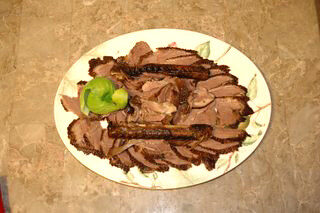Chinese Goose recipes. The following recipe for Teochiu goose was very kindly donated by Bee Zhang, The Cockroach Catcher’s Wife. After reading the post on Chinese New Year and The Goose, I asked her if she would reveal her family recipe. So, here it is!
Bee Zhang: ‘Teochiu is in the north eastern part of Guangdong province, China, and is also referred to as Chaozhou, or Chiuchow. Braised goose is one of the most well-known and popular Teochiu dishes. My husband’s family originated from this region, and I had a recipe from my mother-in-law. However, I have since adapted it somewhat to suit our tastes and to make do with ingredients and cooking utensils that are easily available in England and the US. The recipe is also great for braising duck, which is of course more widely available in the western world’.
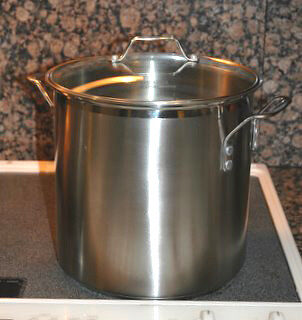
Cooking utensils:
Traditionally, the goose is braised in a large Chinese wok (the size of a very big satellite dish). I imagine very few families living in the western world are likely to have such a wok. I myself have experimented with different cooking utensils over the years. If you have a large oval covered roaster, that would be ideal. A large stockpot or lobster pot (see photo above) may also work if it is deep enough for the goose to stand in with the lid on, although you will have to keep basting the bird during the cooking process. Otherwise, you can cook the goose in a baking tray enclosed in thick kitchen foil. When I tried to prepare this dish for this past Chinese New Year celebration, it suddenly dawned on me that our WMF fish kettle/poacher (see photo below) was of just the right shape and size for a 12-lb goose.
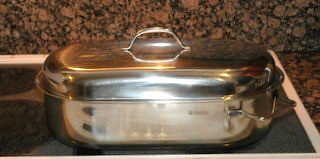
Ingredients: (the quantities can be adapted to your taste.)
- goose – choose one that can fit comfortably into your cooking utensil. If the giblets come with the goose, these can be braised with the goose, and if the liver is included, count yourself lucky! (you can also cook a duck instead)
- dark soy sauce – roughly 4 cups
- light soy sauce – roughly 1 cup
- fresh ginger – 3 to 4 slices (if you cannot get hold of this, you can substitute with 1 to 2 teaspoons of ginger powder)
- 5 spice powder – 2 teaspoons (this is an essential ingredient. If you do not have it, substitute with a mixture of aniseed, cinnamon and allspice/mixed spices.)
- spring onion – two stalks (it does not really matter if you omit this ingredient)
- Chinese cane sugar bars (see photo below) – 1 ½ to 2 bars. (if you cannot get hold of this ingredient, substitute with 1 cup of dark brown sugar)
- salt – for cleaning the goose
- Chinese wine vinegar – 3 tablespoons (for dipping sauce). You can use balsamic vinegar if you like
- fresh garlic – 1 clove (to be finely grated for dipping sauce)
- fresh chilli – a few slivers (for dipping sauce)
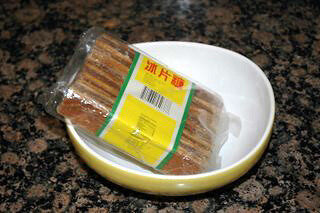
Preparing the dish:
Before I clean the goose, I like to remove the parson’s nose because the oil glands can be quite overpowering. Rub the inside and outside with coarse sea salt, and rinse under a running tap. Then pour boiling water over the bird, collecting the water in a large enough utensil, and turn the bird several times in the hot water. Stuff the bird with ginger and spring onion.
The secret to prevent the goose burning or sticking to the bottom of the pot is to line the pot with a Chinese cabbage (or ordinary cabbage) leaf, although this will not be necessary if you are going to braise the bird in a baking tray in the oven. What is great about using the fish kettle/poacher is that it usually comes with a trivet with adjustable height. I sat the trivet flat at the bottom of the poacher and then placed the goose on it. (see photo below.)
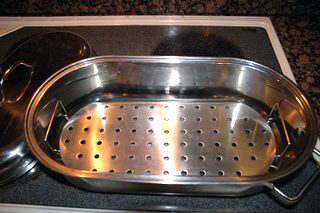
To give the goose a nice golden colour, pour the dark and light soy sauce mixture over the goose and cook for 5 minutes on medium heat, with the lid off. Then turn the goose over, and cook for another 5 minutes. If the lid is left on, the steam will prevent the goose from getting a nice colour. If there appears to be not enough liquid, add more soy sauce.
Add enough hot water to at least half-cover the goose. If you are using the oven method, then pour enough hot water to half fill the baking tray. Add sugar and 5-spice powder. Cover and cook for 30 minutes, first at high heat to bring the mixture to the boil, then at low heat. With the oven method, you will need to cover the bird and the baking tray with thick kitchen foil.
If you are using a deep pot and the goose is standing in the pot instead of lying flat, you will need to baste it every 10 minutes or so during the whole cooking process to give the bird an even flavour and even colour.
After 30 minutes, turn the goose over, and add the giblets. Cook for another 30 minutes, again initially at high heat to bring the mixture back to the boil, and then at low heat. Continue cooking and turning the goose every 30 minutes until goose is done. (Test by using a meat thermometer, or by sticking a chopstick or skewer into the goose where its drumstick joins the body. A clear juice will indicate that the bird is ready).
The cooking time will depend on the weight of the goose and the type of cooking utensil. My 12-lb goose took less than 2 hours to cook, in my good quality heavy duty fish poacher with a good fitting lid.
Turn the bird one final time, remove the lid, and cook for another 5 minutes. Let the goose cool in the braising sauce for an hour before lifting it out. (see photo below)
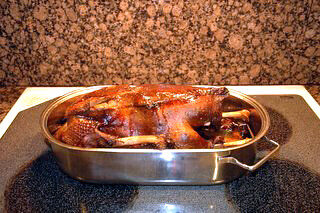
Serving the dish:
I love to cook this dish for parties because it can be prepared well beforehand, and the dish is served cold. In fact, you can prepare it the day before, but remember to cover it with cling film or kitchen foil to keep it moist, and leave the carving to the last minute.
Separate the fat from the braising sauce. You can use a separator, but I find the most effective way is to leave the sauce in the fridge so that the fat solidifies and becomes easily removable. The sauce also turns into a kind of meat jelly. Sometimes, we chop up some small meat jelly cubes and serve them as an accompaniment to the carved goose. The “defatted” sauce itself (the jelly can be conveniently melted in a microwave) is an essential dipping sauce for the dish. My western friends never fail to be amazed by how “non-fatty” my braised goose (or braised duck) dish is, and how much meat we get out of a single bird. To westerners, duck and goose seem to be fatty dishes that do not yield much meat.
An hour before serving, prepare the other dipping sauce to accompany the dish. Finely grate a clove of garlic and thinly slice a small chilli. Flavour the Chinese wine vinegar with the grated garlic and chilli slivers. However, my husband frequently asks me not to present this vinegar sauce when he is serving expensive wines, because he does not want the vinegar to spoil his wine!
Finally, we come to the carving of the goose. For this task, I rely on my husband’s surgical skills, as the goose needs to be carved into large thin slices. Make sure the goose is cold and the carving knife is sharp. Needless to say, the carved goose must be kept wrapped in cling film to prevent any drying’.
Extracts from The Cockroach Catcher –
‘Wines to go with the braised goose:
A good Burgundy or top quality Rhone wine will go well with this dish. If you prefer white, then there is no better match than the little known but wonderful Jurançon from the Pyrenees, the sweet variety is what we prefer as it has enough acid to cut through the fat of goose and the sweetness a good match for the sauces. Then there is always Champagne and our current favourite is Tattinger. The great thing with the basic Champagne from the great houses is its family characteristic. The Tattinger Brut will give you hints of their great Comtes de Champagne. Moet and Chandon remains our all time favourite. Yes, close your eyes and you can taste Dom Perignon’.
‘Goose Fat:
Goose fat is the true come back kid, thanks to the Goddess Nigella Lawson, who recommended it as best for frying potato chips. It has a high smoke point and is now seen as one of the best quality fat’.
Please let Bee Zhang know how your Teochiu goose or ducked turned out!
